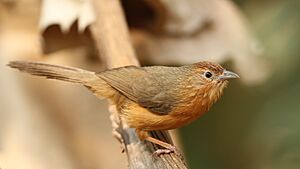Tawny-bellied babbler facts for kids
Quick facts for kids Tawny-bellied babbler |
|
|---|---|
 |
|
| D. hyperythra hyperythra from Satpura National Park |
|
| Conservation status | |
| Scientific classification | |
| Genus: |
Dumetia
|
| Species: |
hyperythra
|
| Synonyms | |
|
|
The tawny-bellied babbler (Dumetia hyperythra) is a small bird that lives in groups. It likes to search for food in low, bushy forests. Sometimes, older books call it the rufous-bellied babbler. Like other birds in the large babbler family, it is a passerine (perching) bird with soft, fluffy feathers.
You can find three main types, or subspecies, of this bird in the Indian Subcontinent. The first type, called hyperythra, lives in northern and eastern India. It has a uniform brown color underneath. The second type, albogularis, lives in western India and has a white throat. The third type, phillipsi, is found in Sri Lanka. It also has a white throat but is lighter in color underneath and has a larger beak.
Contents
What Does the Tawny-bellied Babbler Look Like?
The tawny-bellied babbler is a small bird, about 13 centimeters long. This measurement includes its long, rounded tail. Its outer tail feathers are about half as long as the middle ones.
The bird is dark brown on its back and a reddish-orange color underneath. Its head is a reddish-brown or grayish-brown. The feathers on its forehead are stiff. The tail is olive brown and has faint lines across it. Adult birds in parts of India and Sri Lanka have a white throat. The Sri Lankan type has a bigger and stronger beak and lighter colors on its belly.
How Scientists Classify This Bird
The tawny-bellied babbler was first described by James Franklin in 1831. He placed it in a group called Timalia. Later, in 1852, another scientist named Blyth created a new group, Dumetia, just for this bird. He noticed differences in its stiff forehead feathers and beak shape.
Today, scientists use DNA to study bird relationships. These studies show that the tawny-bellied babbler is closely related to the dark-fronted babbler and the chestnut-capped babbler. It belongs to a larger bird group called Timaliinae.
Where Do Tawny-bellied Babblers Live?
You can find the tawny-bellied babbler from Nepal and central India all the way to Sri Lanka. In India, the different types of these birds mix together. They do not live in completely separate areas.
These birds prefer to live in scrubland and areas with tall grass. In Sri Lanka, they live in hills up to about 1500 meters above sea level.
Behavior and Life Cycle
The tawny-bellied babbler builds its nest in a low bush. It hides the nest well within thick leaves. The nest is shaped like a ball and is made from long, woven leaves of bamboo or grasses.
These birds usually breed from May to September, mostly during the rainy season. A female bird typically lays three or four eggs. Both parents take turns sitting on the eggs to keep them warm. In Sri Lanka, they might raise more than one group of chicks each year.
Like most babblers, these birds do not migrate long distances. They have short, rounded wings and are not very strong fliers. They mainly eat insects. They also drink nectar from flowers, like those of the Bombax and Erythrina trees.
When they are looking for food in bushes, they make chirping, twittering, or harsh chattering sounds. In the Telugu language, people sometimes call them Pandi Jitta, which means "pig bird." This is because they forage under dense bushes, much like pigs do.
Sometimes, Banded bay cuckoos lay their eggs in the nests of tawny-bellied babblers. This means the babblers end up raising the cuckoo chicks.
Gallery




